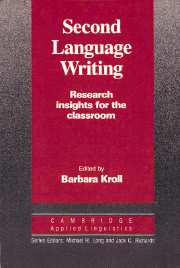Book contents
- Frontmatter
- Contents
- List of contributors
- Series editors' preface
- Preface
- Introduction
- I PHILOSOPHICAL UNDERPINNINGS OF SECOND LANGUAGE WRITING INSTRUCTION
- II CONSIDERATIONS FOR WRITING INSTRUCTION
- Chapter 7 Composing in English: effects of a first language on writing in English as a second language
- Chapter 8 The teaching of topical structure analysis as a revision strategy for ESL writers
- Chapter 9 What does time buy? ESL student performance on home versus class compositions
- Chapter 10 Feedback on compositions: teacher and student verbal reports
- Chapter 11 Teacher response to student writing: focus on form versus content
- Chapter 12 Responding to different topic types: a quantitative analysis from a contrastive rhetoric perspective
- Chapter 13 Writing with others' words: using background reading text in academic compositions
- Index
Chapter 10 - Feedback on compositions: teacher and student verbal reports
Published online by Cambridge University Press: 05 October 2012
- Frontmatter
- Contents
- List of contributors
- Series editors' preface
- Preface
- Introduction
- I PHILOSOPHICAL UNDERPINNINGS OF SECOND LANGUAGE WRITING INSTRUCTION
- II CONSIDERATIONS FOR WRITING INSTRUCTION
- Chapter 7 Composing in English: effects of a first language on writing in English as a second language
- Chapter 8 The teaching of topical structure analysis as a revision strategy for ESL writers
- Chapter 9 What does time buy? ESL student performance on home versus class compositions
- Chapter 10 Feedback on compositions: teacher and student verbal reports
- Chapter 11 Teacher response to student writing: focus on form versus content
- Chapter 12 Responding to different topic types: a quantitative analysis from a contrastive rhetoric perspective
- Chapter 13 Writing with others' words: using background reading text in academic compositions
- Index
Summary
Recent survey work has suggested that there may be a misfit between written feedback teachers provide on compositions and the learners' interests – that is, between what the teachers give and what the students would like to get. Part of the problem lies in the nature of the teacher's feedback, which is unclear, inaccurate, and unbalanced – because it focuses only on certain elements in written output (e.g., grammar and mechanics) and because it overemphasizes negative points (see Marzano and Arthur 1977; Cardelle and Corno 1981; Semke 1984; Zamel 1985; Pica 1986). Furthermore, comments are often not structured enough to help writers to develop their ideas (Butturff and Sommers 1980). Leki (this volume) reviews several of the issues involved in teacher response.
Even in a process approach to L1 (first language) writing with conferencing, peer response groups, and multiple drafts, case study research has found that learner and teacher do not necessarily share common information, skills, and values when they come to the interaction situation (Sperling and Freedman 1987). For example, a teacher's oral clarification of feedback may consist simply of deciphering his or her handwritten responses, which may not be the student's problem. It is further suggested that learners may make changes according to what they think the teacher's values are, out of a belief that the teacher knows best.
In addition, there may be disagreement as to when such feedback should be given. In a large-scale survey of feedback in L1 writing, teachers were seen to favor giving feedback during the writing process, whereas the students preferred their teacher to respond to the final version (Freedman 1987).
- Type
- Chapter
- Information
- Second Language Writing (Cambridge Applied Linguistics)Research Insights for the Classroom, pp. 155 - 177Publisher: Cambridge University PressPrint publication year: 1990
- 57
- Cited by

